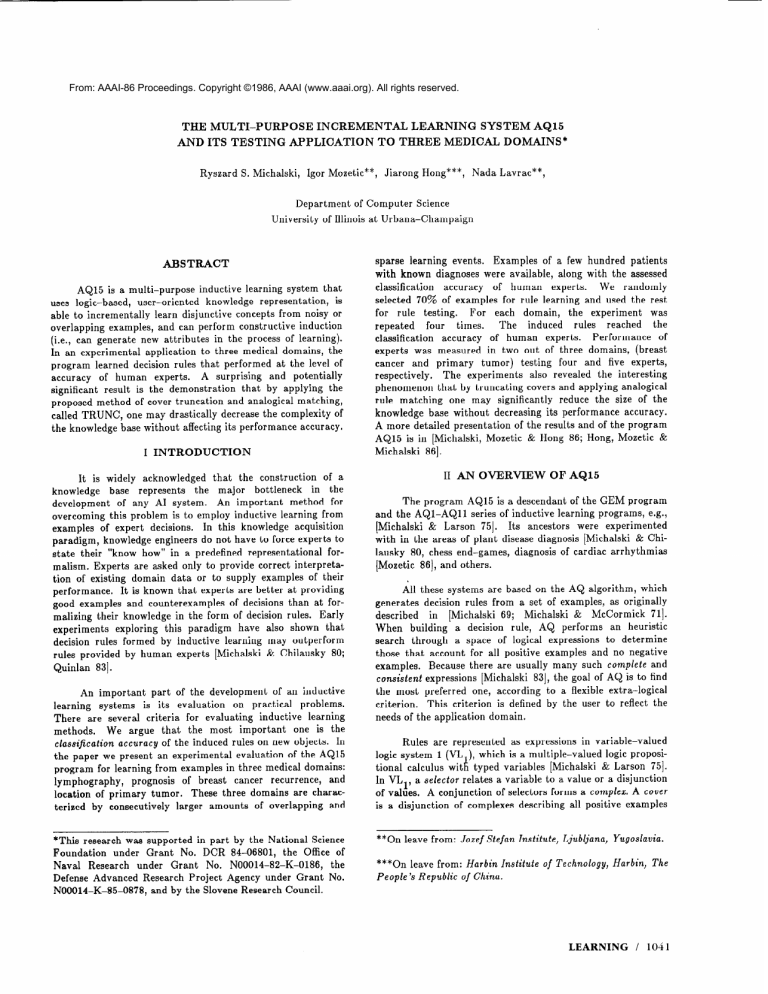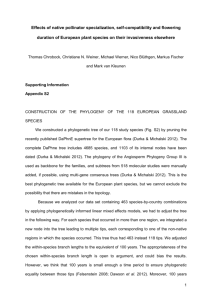
From: AAAI-86 Proceedings. Copyright ©1986, AAAI (www.aaai.org). All rights reserved.
THE
MULTI-PURPOSE
AND
ITS
Ryszard
INCREMENTAL
TESTING
APPLICATION
S. Michalski,
Igor
Mozetic**,
Department
University
of Illinois
ABSTRACT
AQ15
is a multi-purpose
inductive
learning
system
that
uses logic-based,
user-oriented
knowledge
representation,
is
able to incrementally
learn disjunctive
concepts
from noisy or
overlapping
examples,
and can perform
constructive
induction
(i.e., can generate
new attributes
in the process
of learning).
In an experimental
application
to three medical
domains,
the
program
learned
decision
rules that performed
at the level of
accuracy
of human
experts.
A surprising
and potentially
significant
result
is the demonstration
that by applying
the
proposed
method
of cover truncation
and analogical
matching,
called TRUNC,
one may drastically
decrease
the complexity
of
the knowledge
base without
affecting
its performance
accuracy.
I INTRODUCTION
It is widely
acknowledged
that
the construction
of a
knowledge
base
represents
the
major
bottleneck
in the
development
of any AI system.
An important
method
for
overcoming
this problem
is to employ
inductive
learning
from
In this knowledge
acquisition
examples
of expert
decisions.
paradigm,
knowledge
engineers
do not have to force experts
to
state
their
“know
how”
in a predefined
representational
formalism.
Experts
are asked only to provide
correct
interpretation of existing
domain
data or to supply
examples
of their
performance.
It is known
that experts
are better
at providing
good examples
and counterexamples
of decisions
than at formalizing
their knowledge
in the form of decision
rules.
Early
experiments
exploring
this paradigm
have
also shown
that
decision
rules formed
by inductive
learning
may outperform
rules provided
by human
experts
[Michalski
& Chilausky
80;
Quinlan
831.
An important
part of the development
of an inductive
learning
systems
is its evaluation
on practical
problems.
There
are several
criteria
for evaluating
inductive
learning
methods.
We argue
that
the most
important
one is the
classification
accuracy
of the induced
rules on new objects.
In
the paper we present
an experimental
evaluation
of the AQ15
program
for learning
from examples
in three medical
domains:
lymphography,
prognosis
of breast
cancer
recurrence,
and
These
three domains
are characlocation
of primary
tumor.
terized
by consecutively
larger
amounts
of overlapping
and
*This
research
WAS supported
in part by the National
Science
Foundation
under
Grant
No. DCR
84-06801,
the Office
of
Naval
Research
under
Grant
No. N00014-82-K-0186,
the
Defense
Advanced
Research
Project
Agency
under
Grant
No.
N00014-K-85-0878,
and by the Slovene Research
Council.
LEARNING
TO
THREE
Jiarong
of Computer
SYSTEM
MEDICAL
Hong***,
AQ15
DOMAINS*
Nada
Lavrac**,
Science
at Urbana-Champaign
sparse
learning
events.
Examples
of a few hundred
patients
with known
diagnoses
were available,
along with the assessed
classification
accuracy
of human
experts.
We
randomly
selected
70% of examples
for rule learning
and used the rest
for
rule
testing.
For
each
domain,
the experiment
was
repeated
four
times.
The
induced
rules
reached
the
classification
accuracy
of human
experts.
Performance
of
experts
was measured
in two out of three
domains,
(breast
cancer
and primary
tumor)
testing
four
and five experts,
respectively,
The experiments
also revealed
the interesting
phenomenon
that by truncating
covers and applying
analogical
rule matching
one may
significantly
reduce
the size of the
knowledge
base without
decreasing
its performance
accuracy.
A more detailed
presentation
of the results
and of the program
AQ15
is in [Michalski,
Mozetic
& Hong 86; Hong, Mozetic
&
Michalski
861.
II
AN
OVERVIEW
OF
AQ15
The program
AQ15
is a descendant
of the GEM program
and the AQl-AQll
series of inductive
learning
programs,
e.g.,
[Michalski
& Larson
751.
Its ancestors
were
experimented
with in the areas of plant disease diagnosis
[Michalski
& Chilausky
80, chess end-games,
diagnosis
of cardiac
arrhythmias
(Mozetic
861, and others.
All these systems
are based on the AQ algorithm,
which
generates
decision
rules from
a set of examples,
as originally
described
in
[Michalski
69;
Michalski
& McCormick
711.
When
building
a decision
rule,
AQ
performs
an heuristic
search
through
a space of logical
expressions
to determine
those
that account
for all positive
examples
and no negative
examples.
Because
there are usually
many
such complete
and
consistent
expressions
[Michalski
831, the goal of AQ is to find
the most
preferred
one, according
to a flexible
extra-logical
This criterion
is defined
by the user to reflect
the
criterion.
needs of the application
domain.
Rules
are represented
logic system
1 (VL ), which
tional
calculus
wit it typed
In VL1, a selector
relates
a
of values.
A conjunction
of
is a disjunction
of complexes
**On
***On
People’s
leave
leave
from:
from:
Republic
Josef
as expressions
in variable-valued
is a multiple-valued
logic proposivariables
[Michalski
8z Larson
751.
variable
to a value or a disjunction
selectors
forms
a complex.
A cover
describing
all positive
examples
Stefun
Harbin
of China.
Institute,
Institute
Ljubljana,
of Technology,
LEARNING
Yugoslavia.
Harbin,
The
/
104 1
and none of the negative
defines the condition
part
examples
of the
of a corresponding
concept.
decision
A cover
rule.
AQl5
is able to produce
rules of different
degrees of generality
(rules
may be general,
minimal
or specific).
The program
implements
incremental
learning
with perfect
memory.
The user may supply
his decision
hypotheses
as initial
rules.
In this type of learning
the system
remembers
all learning
examples
that were seen so far, as well as the rules it formed
[Reinke
& Michalski
861. A f orm of constructive
induction
is
implemented
in AQ15
as well.
The program’s
background
knowledge,
expressed
in the form of rules, is used to generate
new attributes
not present
in input
data.
The background
knowledge
rules are of two types:
L-rules
that define values of
new variables
by logical
assertions,
and A-rules
that introduce
new variables
as arithmetic
functions
of original
variables.
III
TRUNCATION
ANALOGICAL
OF COVERS
MATCHING
In AQ15
a concept
is represented
in the form of a simple
conjunctive
statement
(called
a complex),
or as a disjunction
of
such statements.
Each statement
is associated
with a pair of
weights:
t and u, representing
the total number
of instances
(events)
explained
by the expression,
and the number
of events
explained
uniquely
by that
expression,
respectively.
The tweight
may be interpreted
as a measure
of the representativeness of a complex
as a concept
description.
The u-weight
may
be interpreted
as a measure
of importance
of the complex.
The complex
with the highest
t-weight
may be interpreted
as
describing
the most
typical
examples
of the concept.
It may
also be viewed
as a prototypical
or the ideal definition
of the
concept.
The complexes
with lowest
u-weights
can be viewed
as describing
rare,
exceptional
cases. If the learning
events
from which
rules are derived
are noisy,
such “light”
complexes
may be indicative
of errors in the data.
Two methods
of recognizing
the concept
membership
of
an instance
are distinguished:
the strict match
and the analogical match.
In the strict
match,
one tests whether
an instance
satisfies
condition
part of a rule.
In the analogical
match,
one
determines
the degree
of similarity
or conceptual
closeness
between
the instance
and the condition
part.
Using the strict
match,
one can recognize
a concept
without
checking
other
candidate
concepts.
In the analogical
match,
one needs to
determine
the most
closely
related
concept.
The
analogical
matching
can be accomplished
in a variety
of ways,
ranging
from approximate
matching
of features
to conceptual
cohesiveness (Michalski
& Stepp
831.
The above
weight-ordering
of complexes
suggests
an
interesting
possibility.
Suppose
we have a t-weight
ordered
disjunction
of complexes,
and we remove
from
it the lightest
complex.
So truncated
description
will not strictly
match
events
that uniquely
satisfy
the truncated
complex.
However,
by applying
the analogical
match,
these events may still come
out to be the most similar
to the correct
concept,
and thus be
correctly
recognized.
A truncated
description
is of course
simpler,
but carries
a potentially
higher
risk of recognition
/ ENGINEERING
CPXl
1
CPX2
;.;.;?--:I
AND
The underlaying
idea behind
the TRUNC
method
is that
the meaning
of a concept
can be distributed
between
its explitit
representation
and
the
method
of its
interpretation
(Michalski
86a, Michalski
86b].
This idea can be simply
realized as described
below.
1042
error,
and requires
a somewhat
more sophisticated
evaluation.
We can proceed
further
and remove
the next “light”
complex
from
the cover,
and observe
the performance.
Each such step
produces
a different
trade-off
between
the complexity
of the
description
on one side, and the risk factor
and the evaluation
complexity
on the other
(Figure
1). At some step the best
overall
result
may be achieved
for a given application
domain.
This
method
of knowledge
reduction
by truncating
ordered
covers
and applying
analogical
matching
is called TRUNC.
I
‘b
I
la
I
‘C
Figure
1. An example
of a t-ordered
cover. The cuts
and c mark truncated
covers
with 1, 2 or 3 complexes,
In each pair (x, y), x represents
the t-weight,
tively.
represents
the u-weight.
at a, b
respecand y
The above
trade-off
is related
to the issues studied
in
Variable
Precision
Logic
[Michalski
& Winston
861.
An
interesting
problem
is to test how the cover truncation
method
affects
the accuracy
of recognition
and the complexity
of the
decision
rules
in different
practical
settings.
Section
IV
presents
results
of some such experiments,
which
in some cases
came out very surprising.
We now turn to the problem
of analogical
matching,
and the resolution
of conflict
when several
concept
descriptions
are matched
by an event.
When
strictly
matching
a new event against
a set of (disjunctive)
rules, three outcomes
are possible:
there may be only
one match,
more than one, or no match
(categories
called SINGLE,
MULTIPLE
and NO-MATCH,
respectively;
Figure
2).
Each category
requires
a different
evaluation
procedure,
and a
different
method
of determining
the accuracy
of concept
recognition.
For exact match
(category
SINGLE),
the evaluation
is
easy: the decision
is counted
as correct
if it is equal to the
known
classification
of the testing
object
and as wrong
otherwise. If there are several
exact matches
(the MULTIPLE
case)
or none (the NO-MATCH
case) the system
activates
the fEezib/e evaluation
scheme
that determines
the best decision
(or the
most probable
one).
Comparing
this decision
with the decision
provided
by experts,
one evaluates
it as correct
or incorrect.
Here we propose
two simple
heuristic
classification
criteria,
one
for
the
MULTIPLE
case,
and
the
other
for
the
NO-MATCH
case.
~Y2$i$Lii~
SINGLE
Figure
against
MULTIPLE
2. The three possible
a set of decision
rules.
cases when
matching
a new
event
Estimate
of Probability
for the MULTIPLE
case (EP).
Let Cl, . . . ,C
denote
decision
classes and e an event
to be
classified.
FoFeach
decision
class C. we have a rule that consists of a disjunction
of complexes
in turn
are
i Cpz 1, which,
conjunctions
of selectors
(Sel). We define the estimate
of probability,
EP, as follows:
1) ,!?p of a complex
Cpx. is the ratio of the weight
of the complex (the number
of lea&ring
examples
covered
by it) by the
total number
of learning
examples
(#examples),
if the complex
is satisfied
by the event e, and equals 0 otherwise:
( Cpxj)
Weight
EP(Cpxj,e)
/ #examples
if complex
=
satisfied
0
Cpx,
is
by e,
otherwise.
2) EP of a class Ci is the probabilistic
sum of EPs of its complexes.
If the rule for C. consists
of a disjunction
of two complexes CpxI
V Cpx2, we h ave:
= EP(Cpzl,e)
EP(Ci,e)
+ EP(Cpz,,e)
- EP(Cpzl,e)
EP(Cpx2,e)
The most probable>
class is the one with the largest
EP,
i.e.,
the one whose
s:ll,isficd
complexes
cover
the largest
number
of learning
ex:~rrrl)lc~s.
Obviously,
if the class is not
satisfied
by the given event, its EP equals 0.
Measure
of Fit for the NO-MATCH
case (MF).
In this
case the event belongs
to a part of the decision
space that is
not covered
by any decision
rule and this calls for analogical
matching.
One way to perform
such matching
is to measure
the fit between
attribute
values
in the event
and the class
description,
taking
into consideration
the prior
probability
of
the class.
We used in the experiments
a simple
measure,
called
measure
offit,
MF, defined as follows:
Se1 k is 1, if the selector
is proportional
to the
by the selector:
1) MF of a selector
wise, this measure
sion space covered
I
MF(SeZk,e)
1
=
I
I
if selector
#Values
is satisfied.
Otheramount
of the deci-
Sel, is satisfied
by e,
otherwise.
DomainSize
where
#Values
values
in the
the attribute’s
is the
selector,
possible
number
of disjunctively
and DomainSize
is the
values.
linked
attribute
total number
of
2) MF of a complex
Cpxi is definr,d
>js the product
of MFs
a conjunction
of its constituent
selrc,tors,
weighted
by the
portion
of learning
examples
covered
by the complex:
MF(Cpxj,e)
3) M.
junction
MF(Ci,e)
= flMF(Selk,e)
of a class Ci is obtained
of complexes.
= MF(Cpxl,e)
X (Weight(Cpxj)
as a probabilistic
+ MF(Cpx,,e)
for
pro-
/ #examples)
sum
- MF(Cpxl,e)
We can interpret
the measure
of best fit of
combination
of “closeness”
of the event to a class
mate of the prior
probability
of the class.
This
be further
extended
by introducing
a measure
which
a selector
is satisfied
[Michalski
& Chilausky
for
a dis-
IV
EXPERIMENTS
AND
ANALYSIS
OF
RESULTS
The experiments
were
performed
on data
from
three
medical
domains:
lymphography,
prognosis
of breast
cancer
recurrence
and location
of primary
tumor
(Table
1). All data
were obtained
from the Institute
of Oncology
of the University
Medical
Center
in
Ljubljana,
Yugoslavia
[Kononenko,
BratI
& I?oskar
861.
Lyrnyhq:r:q~hy.
This domain
is characterized
classes
(diagnoses)
and 18 attributes.
Data
were available.
Diagnoses
in this domain
were
actual
testing
of physicians
was not done. A
mation
is that internists
diagnose
correctly
in
specialists
in about 85% of cases.
by 4 decision
of 148 patients
not verified
and
specialist’s
estiabout
60% and
Prognosis
of Breast
Cancer
Recurrence.
The domain
is
characterized
by 2 decision
classes and 9 attributes.
The set of
attributes
is incomplete
as it is not sufficient
to completely
discriminate
between
cases with
different
outcome.
Data for
286 patients
with
known
diagnostic
status
5 years
after
the
operation
were available.
Five specialists
that were tested gave
a correct
prognosis
in 64% of cases.
Location
of
Primary
tumor.
Physicians
distinguish
between
22 possible
locations
of primary
tumor.
Patients’
diagnostic
data involve
17 attributes
(this set is also incomplete).
Data of 339 patients
with known
locations
of primary
tumor
were available
for the experiment.
Four
internists
that
were tested
determined
a correct
location
of primary
tumor
in
32% of cases and four oncologists
(specialists)
in 42% of test
cases.
Domain
Examples
Lymphography
Breast
cancer
Primary
tumor
Table
classes,
attribute
1.
of
148
286
339
Classes
4
2
22
Attrs
Vals
Attr
18
9
17
3.3
5.8
2.2
The
table
presents
the number
of examples,
attributes,
and the average
number
of values
for each of the three medical
domains.
of
per
In all medical
domains
70% of examples
were selected
for
learning
and the remaining
30%
for testing.
Each
testing
experiment
was repeated
4 times with randomly
chosen
learning examples.
Final
results
are the average
of 4 experiments
(Table
2).
In addition
to results
obtained
from
using
complete
(untruncated)
rules,
results
of two
other
experiments
are
presented.
In the first experiment
we eliminated
from rules all
complexes
that
cover
uniquely
only
one learning
example
(unique
>l),
and in the second
we eliminated
all complexes
except
the
most
representative
one covering
the
largest
number
of learning
examples
(best cpx).
Complexity
of rules is
measured
by the number
of selectors
and complexes.
MF(Cpx2,e)
a class as a
and an estimeasure
can
of degree
to
801.
Table
2 shows that some results
came out very surprising.
When
the cover of each class was truncated
to only one
(the heaviest)
complex,
the complexity
of the rule set for lymphography
went down from the total of 12 complexes
and 37
selectors
to only 4 complexes
(one per class) and 10 selectors
(see bold numbers).
At the same time the performance
of rules
LEARNING
/
1043
Domain
Lymphography
Breast
Primary
cancer
tumor
Cover
truncation
no
unique
>l
best cpx
no
unique
> 1
best cpx
Complexity
Se1
CPX
37
12
34
10
10
4
no
unique
>l
best cpx
2. Average
complexity
as compared
4 experiments,
classification
algorithm.
Table
and
to
41
60%
32
2
66%
68%
551
257
112
104
42
20
39%
41%
29%
1044
/
ENGINEERING
3. Average
complexity
truncation
mechanism
Random
Choice
85%
(estimate)
25%
64%
50%
42%
5%
accuracy
of AQ15’s
rules learned
from
the performance
of human
experts
It is surprising
that a cover truncation
mechanism
that
strongly
simplifies
the rule
base
may
have
no effect
on
classification
accuracy.
Removing
“light”
complexes
from
a
cover is equivalent
to removing
disjunctively
linked
conditions
cover
80%
82%
128
7
The domain
of lymphography
seems to have some strong
patterns
and the set of attributes
is known
to be complete.
There
are four possible
diagnoses
but only two of them
are
prevailing.
The d omain of breast
cancer has only two decision
classes
but does not have many
strong
patterns.
Domain
of
location
of primary
tumor
has many
decision
classes
and
There
are only a few examples
per
mostly
binary
attributes.
class,
and the domain
seems to be without
any strong
patterns.
Both domains
are underspecified
in the sense that the
set of available
attributes
is incomplete
(not
sufficient
to
discriminate
between
different
classes).
The statistics
in Table
3 include
average
number
of complexes
per rule,
average
number
of attributes
per complex,
average
number
of values
per attribute
and finally,
average
number
of learning
examples
We can see that
in the domain
of
covered
by one complex.
primary
tumor
decision
rules
consist
of complexes
that
in
average
cover slightly
more than 2 examples.
In the domain
of
lymphography
complexes
in average
cover 8 examples,
which
indicates
a presence
of relatively
strong
patterns.
Table
Human
Experts
81%
160
A similar
phenomenon
went slightly
up (f rom 81% to 82%)!
occurred
in the breast
cancer
domain,
where
the number
of
selectors
and complexes
went down from
160 and 41 to 7 and
2, respectively;
while the performance
went slightly
up from
66% to 68%.
This means that by using the TRUNC
method
one may
significantly
reduce
the knowledge
base without
affecting
its performance
accuracy.
Results
for human
experts
are the average
of testing
of five and four domain
specialists
in
the domains
of breast
cancer
recurrence
and primary
tumor,
respectively
[Kononenko,
Bratko
& Roskar
86).
In
the
domain
of lymphography,
physicians’
accuracy
is given only as
their estimate
and was not, actually
measured.
Domain
Lymphography
Breast
cancer
Primarv
tumor
Accuracy
Cpx/Rule
3
20
5.2
of AQ15’s
was applied.
of examples,
a random
over
choice
from a concept
description.
This process
thus overspecializes
a
knowledge
representation,
producing
an incomplete
concept
description
(i.e., a one that does not cover some positive
examples).
As the results
show,
this may lead to a substantial
simplification
of the concept
description,
without
the decline in
performance
of the rules base.
This
knowledge
reduction
technique
by specialization
may be contrasted
with knowledge
reduction
by generalization
used in the ASSISTANT
learning
program,
a descendant
of
ID3 [Quinlan
83).
This program
represents
knowledge
in the
form of decision
trees, and has been applied
to the same medical problems
as here (Kononenko,
Bratko
& Roskar
861. The
program
applies
a tree pruning
technique
based on the principle of maximal
classification
accuracy.
The technique
removes
certain
nodes from
a tree, and is equivalent
to removing
conjunctively
linked
conditions
from a concept
description.
Thus,
such
? knowledge
reduction
technique
overgeneralizes
the
knowledge
representation,
producing
an inconsistent
concept
description
(i.e., a one that covers some negative
examples).
It
is interesting
to point out that this technique
may also lead to
an improvement
of accuracy
in decision
making
when learning
from
noisy
and overlapping
data.
Table 4 presents
the complexity
and diagnostic
accuracy
of ASSISTANT’s
trees built
with
and without
the tree pruning
mechanism
[Kononenko,
Bratko
& Roskar
861.
Tree
pruning
corresponds
to the removal
of selectors
from
complexes.
This
seems to suggest
that
when learning
from
noisy
or overlapping
data the knowledge
reduction
process may not only involve
removal
of complexes
from
a cover
(a specialization
process)
but also removal
of selectors
from
complexes
(a generalization
process).
This means
that a concept description
would
be both inconsistent
and incomplete.
It
is an interesting
problem
for further
research
to determine
conditions
under
which
such
a description
produces
better
results
than a consistent
and complete
one.
Attrs/Cpx
3.1
3.9
5.3
decision
70%
and
Examples/Cpx
Values/Attr
1.8
1.7
1.0
rules
in the
8
5
2.3
three
medical
domains,
when
no
I
1
Domain
Tree
pruning
no
Complexity
Leaves
Nodes
38
22
Accuracy
1
PI
76%
PI
PI
Table
4. Average
complexity
and accuracy
of decision
trees
built by ASSISTANT
on 70% of examples,
over 4 experiments.
In all three domains
the tree pruning
mechanism
reduced
the
complexity
and increased
the accuracy.
V
CONCLUSION
A major
contribution
of the paper is to show that a relatively
simple,
attribute-based
inductive
learning
method
is
able to produce
decision
rules of sufficiently
high quality
to be
applicable
to practical
problems
with noisy,
overlapping
and
incompletely
specified
learning
events.
The AQ15 program
has
shown
itself to be a powerful
and versatile
tool for experimenting with inductive
knowledge
acquisition
in such problems.
It
produces
decision
rules
which
are easy to interpret
and
comprehend.
The knowledge
representation
in the program
is
limited,
however,
to only
attribute-based
descriptions.
For
problems
that require
structural
descriptions
one may use a
related
program
INDUCE2
[Hoff, Michalski
& Stepp
831 or its
incremental
learning
version
INDUCE4
[Mehler,
Bentrup
&
Riedsel
861. A weakness
of the experimental
part of the paper
is that the authors
had no influence
on the way the data were
prepared
for the experiments
and the available
data allowed
us
to test only a few of the features
of AQ15.
Another
major
result
is a demonstration
that
the
knowledge
reduction
by truncating
the covers
may
lead in
some cases to a substantial
reduction
of the rule base without
decreasing
its performance
accuracy.
Further
research
will be
required
to find for any given domain
a rule reduction
criterion
that leads to the best trade-off
between
accuracy
and complexity of a rule base.
ACKNOWLEDGEMENTS
The
authors
thank
Ivan
Bratko
and Igor
Kononenko
from
the Faculty
of Electrical
Engineering
at University
of
Ljubljana
for collaboration
and comments,
and physicians
Matjaz
Zwitter
and
Milan
Soklic
from
the Institute
of
Oncology
at the University
Medical
Center
in Ljubljana
for
providing
medical
data
and helping
to interpret
them.
We
further
acknowledge
Gail Thornburg
from
the UI School
of
Library
and Information
Science
and the AI Laboratory
at the
Dept.
of Computer
Science
for her criticism
and valuable
suggestions.
151
PI
PI
PI
PI
[lo]
11
1
12
1
131
141
[15]
[ 161
REFERENCES
[l]
Hong,
J., Mozetic,
I., Michalski,
R.S.
(1986).
“AQ15:
Incremental
Learning
of Attribute-Based
Descriptions
from
Examples,
the Method
and User’s
Guide.”
Report
ISG 86-5, UIUCDCS-F-86-949,
Dept.
of Computer
Science, University
of Illinois,
Urbana.
Hoff, W., Michalski,
R.S., Stepp, R.E. (1983).
“INDUCE.2:
A Program
for Learning
Structural
Descriptions
from
Examples.”
Report
ISG 83-4, UIUCDCS-F-83-904,
Dept.
of Computer
Science,
University
of Illinois,
Urbana.
Kononenko,
I., Bratko,
I., Roskar,
E. (1986).
“ASSISTANT:
A System
for Inductive
Learning.”
Informatica
Journal,
Vol. 10, No. 1, (in Slovenian).
Mehler,
G., Bentrup,
J., Riedesel
J. (1986).
“INDUCE.4:
A
Program
for Incrementally
Learning
Structural
Descriptions
from
Examples.”
Report
in preparation,
Dept.
of
Computer
Science,
University
of I!linois,
Urbana.
Michalski,
R.S. (1969).
“On the Quasi-Minimal
Solution
of the General
Covering
Problem.”
Proceedings
of the V
International
Symposium
on
Information
Processing
(FCIP
69), Vol. A3 (Switching
Circuits),
Bled, Yugoslavia, pp. 125-128.
Michalski,
R.S.
(1983).
“Theory
and Methodology
of
Machine
Learning.”
In R.S. Michalski,
J.G. Carbonell,
T.M.
Mitchell
(Eds.),
Machine
Learning
- An Artificial
Intelligence
Approach,
Palo Alto: Tioga.
Michalski,
R.S. (1986a).
“Concept
Learning.”
To appear
in
AI Encyclopedia,
John Wiley
& Sons.
Michalski,
R.S. (1986b).
“T wo-tiered
Concept
Representation, Analogical
Matching
and Conceptual
Cohesiveness.”
Invited
paper for the Workshop
on Similarity
and Analogy,
Allerton
House,
University
of Illinois,
June 12-14.
Michalski,
R.S.,
Chilausky,
R.L.
(1980).
“Learning
by
Being Told and Learning
from Examples:
An Experimental
Comparison
of the
Two
Methods
of Knowledge
Acquisition
in the Context
of Developing
an Expert
System for Soybean
Disease Diagnosis.”
International
Journal
of Policy
Analysis
and Information
Systems,
Vol. 4, No. 2,
pp. 1255161.
Michalski,
R.S.,
Larson,
J. (1975).
“AQVAL/l
(AQ7)
User’s
Guide
and Program
Description.”
Report
No. 731,
Dept. of Computer
Science,
University
of Illinois,
Urbana.
Michalski,
R.S., McCormick,
B.H. (1971).
“Interval
Generalization
of Switching
Theory.”
Report
No. 442, Dept.
of Computer
Science,
University
of Illinois,
Urbana.
Michalski,
R.S., Mozetic,
I., Hong,
J. (1986).
“The AQ15
Inductive
Learning
System:
An Overview
and Experiments.”
Report
ISG 86-20,
UIUCDCS-R-86-1260,
Dept.
of Computer
Science,
University
of Illinois,
Urbana.
Michalski,
R.S.,
Stepp,
R.E.
(1983).
“Learning
from
Observations:
Conceptual
Clustering.”
In R.S. Michalski,
J.G. Carbonell,
T.M.
Mitchell
(Eds.), Machine
Learning
An Artificial
Intelligence
Approach,
Palo Alto: Tioga.
Michalski,
R.S., Winston,
P.H. (1986).
“Variable
Precision
Logic.”
AI memo No. 857, MIT,
Cambridge.
An extended
version
to appear
in AI Journal.
Mozetic,
I. (1986).
Extraction
through
Learn“K nowledge
ing from
Examples.”
In T.M.
Mitchell,
J.G. Carbonell,
R.S. Michalski
(Eds.),
Machine
Learning:
A Guide
to
Current
Research,
Kluwer
Academic
Publishers.
J.R.
(1983).
“L earning
Efficient
Classification
Quinlan,
Procedures
and their Application
to Chess End Games.”
In R.S. Michalski,
J.G. Carbonell,
T.M.
Mitchell
(Eds.),
Machine
Learning
- An Artificial
Intelligence
Approach,
Palo Alto: Tioga.
Reinke,
R.E., Michalski,
R.S. (1986).
“Incremental
Learning of Decision
Rules:
A Method
and
Experimental
Results.”
To appear
in J.E. Hayes, D. Michie,
J. Richards
(Eds.),
Machine
Intelligence
1.2, Oxford
University
Press.
[17]
LEARNING
/
1045






